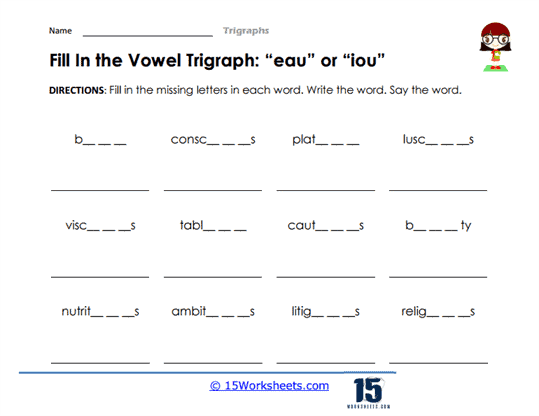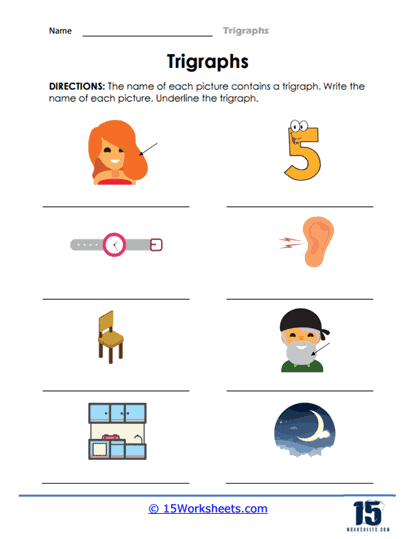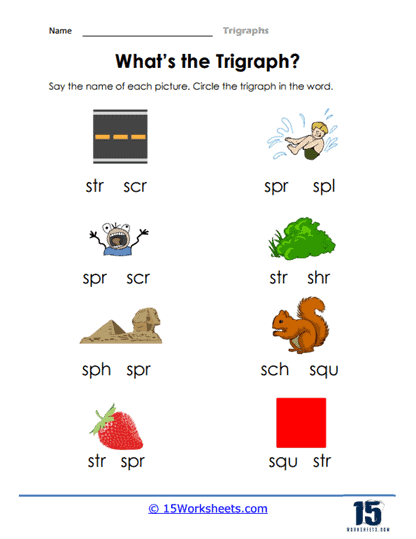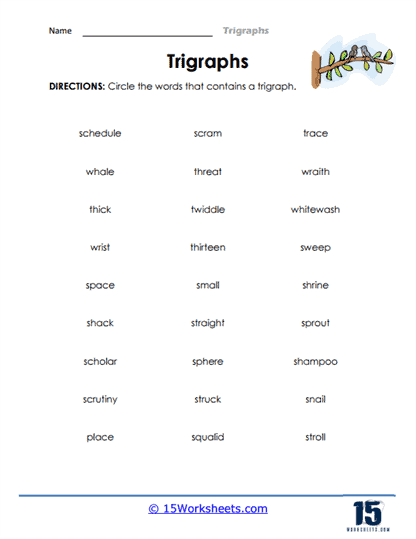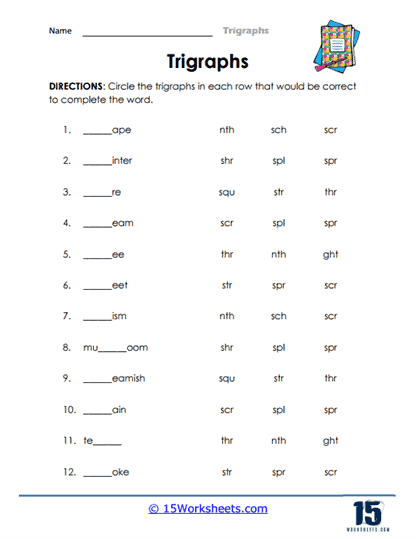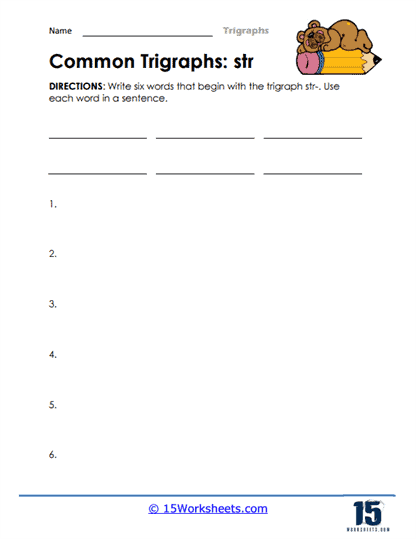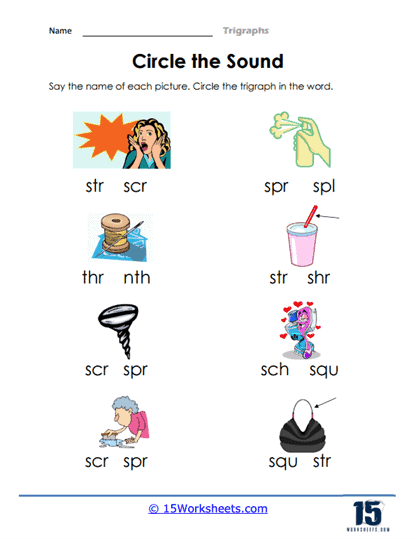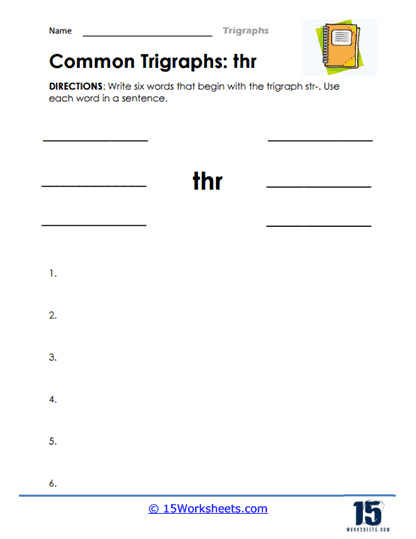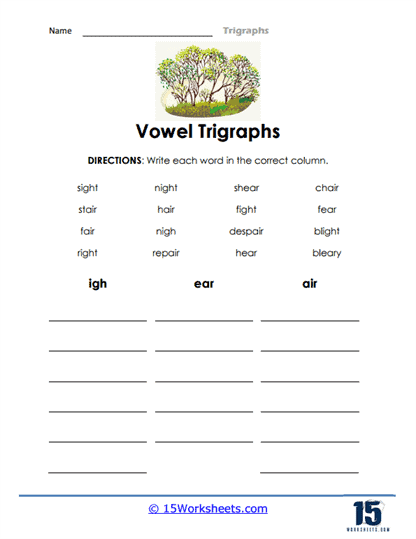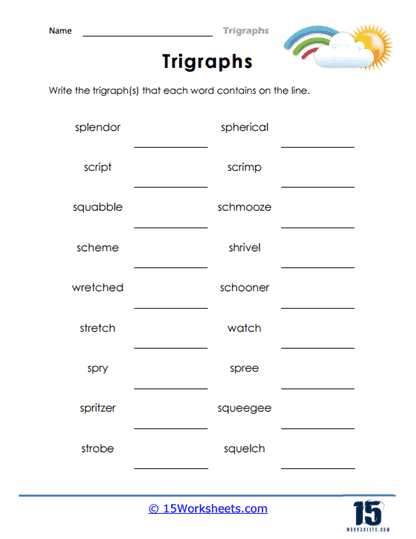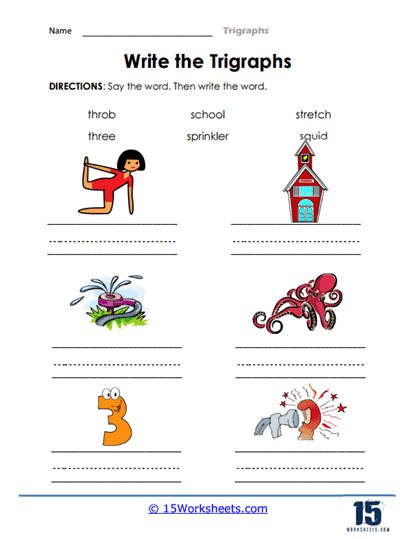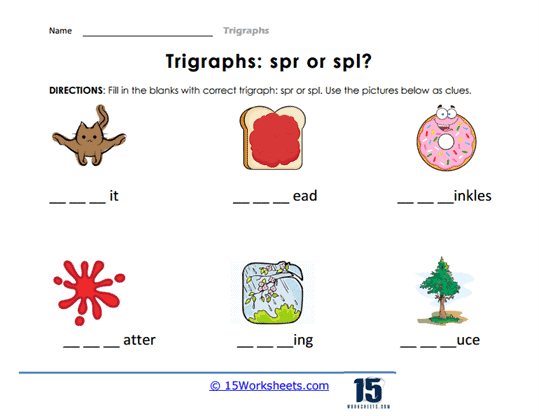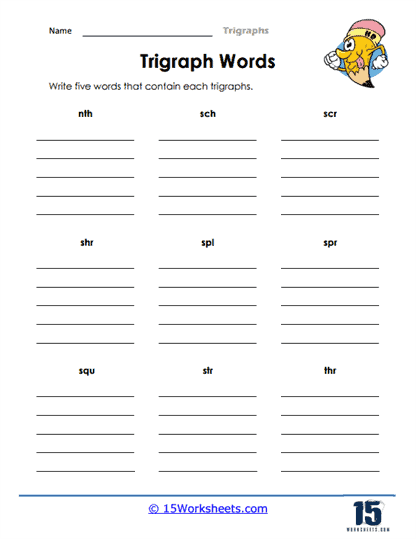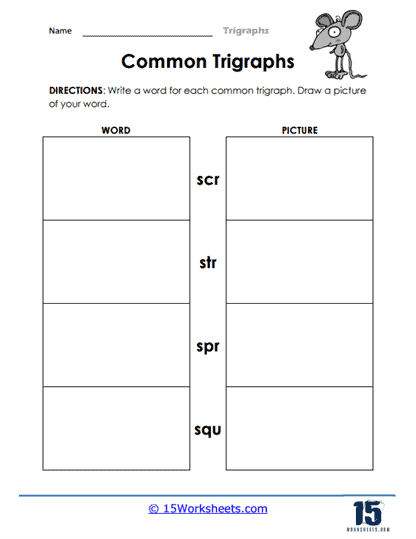Trigraphs Worksheets
All About These 15 Worksheets
This collection of worksheets focuses on developing students’ understanding and application of trigraphs in phonics and reading. Trigraphs are combinations of three letters that produce a single sound, and these worksheets offer a variety of exercises that help students recognize and use these letter combinations effectively. The exercises are designed to enhance phonemic awareness, spelling skills, and word recognition-all crucial aspects of literacy development.
Phonics Skills
The worksheets emphasize the identification of trigraphs within words, encouraging students to recognize the distinct sound that three-letter combinations make. By having students search for and circle trigraphs, these worksheets foster careful attention to letter patterns. The exercises likely include common English trigraphs like “str,” “spr,” “spl,” and “scr,” which are important for both pronunciation and spelling. This type of phonics work reinforces students’ decoding skills, enabling them to break down words into their sound parts and understand how letters combine to form sounds.
Reading and Word Recognition Skills
These worksheets also integrate picture-based tasks that tie trigraphs to visual cues, helping students match images to words that contain trigraphs. This not only aids in phonics but also enhances vocabulary and word recognition. By associating the visual representation of words with their trigraphs, students strengthen their ability to recognize common words that follow specific phonetic rules. This approach supports early reading comprehension, as recognizing patterns in words makes it easier for students to read more fluently.
Spelling and Writing Development
Many of the tasks in this collection ask students to either complete or write words with trigraphs. This practice allows students to apply their knowledge of trigraphs in a written format, further solidifying their understanding of how these sounds function within words. Such exercises are essential for developing spelling accuracy and for reinforcing the connection between phonics knowledge and writing skills.
Critical Thinking and Application
The worksheets encourage students to think critically about the role of trigraphs in different word contexts. For instance, by completing words with the appropriate trigraph, students must not only recognize the pattern but also understand the meaning of the word and how it is constructed. This helps in developing both language and cognitive skills as students engage in problem-solving while learning the intricacies of English spelling and phonics.
What Is A Trigraph?
A trigraph is a single sound made by a combination of three letters. These three letters can be consonants, vowels, or a combination of both. For example, in the word ‘catch’, ‘tch’ at the end are three letters, but they make only one sound.
Some more examples of trigraphs are:
– ear in the words hear, disappear, beard, spear
– igh in the words sigh
– air in the words fair, chair, stair, hair
– are in the words dare, glare, care, bare
– ore in the words bore
– eau in the words chateau, plateau, gateau
Some trigraphs are read as a single word on their own! A few examples are:
– owe
– awe
– ewe
– aye
– eye
Here, the letters ‘w’ and ‘y’ act as a vowel.
Consonant Trigraphs
Consonants Trigraphs are groups of three consonants with words that make a new consonant sound.
Examples of Consonant Trigraphs
1. Sch
Schedule, scheme, schematic, scherzo, schism, scholastic, schizophrenic, schlock, schlep, schmooze, scholar, scholarship, schooner, school, schoolroom
2. Scr
Scrap, scram, screenwriter, screw, scramble, scrapbook, scrape, scribble, scribe, scrappy, scratch, scream, screech, screen, screwball, screwdriver, scrimmage, scruples, scrawl, scrawny, scrutinize, scrutiny
3. Shr
Shred, shrank, shrapnel, shrew, shrift, shrill, shrewd, shriek, shrine, shrink, shrimp, shrivel, shroud, shrug, shrunk, shrub
4. Sph
Sphere, sphagnum, sphincter, spherical, spheroid, sphinx
5. Spl
Splat, splash, splay, spleen, splashdown, splendid, splendor, splatter, splinter, splice, splint, split, splurge, splutter, splotchy
6. Spr
Sprawl, sprain, spread, sprang, spray, spree, sprig, spreadsheet, spring, springtime, springboard, springbok, sprinkle, sprinkler, sprite, spritz, sprint, sprocket, sprout, spritzer, sprung, spry, spruce
7. Squ
Squab, squabble, squalid, squad, squadron, squalor, squall, squash, squat, squander, square, squawk, squeal, squeamish, squeak, squelch, squib, squeegee, squid, squiggle, squeeze, squire, squirm, squint, squirt, squish, squirrel,
8. Str
Strut, straight, strand, strange, strain, strait, stroke, strap, straw, strong, struck, streak, strum, strung, stream, strawberry, stray, street, strength, stress, stretch, strict, string, stripe, strobe, stroll
9. Thr
Throw, thrash, thread, thrush, thrust, threat, three, threw, thriller, thrive, thrice, thresher, thrift, throat, throb, throne, throng, throttle, through
Vowel Trigraphs
Vowel Trigraphs are the three letter groups made up of vowels only, i.e, a,e,i,o,u.
Examples of Vowel Trigraphs:
1. Eau
Beau, bureaucracy, beauty, bureaucrat, chateau, bureaucratize, beautiful, beautician, bureaucratic, beauteous, portmanteau, tableau, plateau, bureau
2. Eou
Advantageous, curvaceous, cretaceous, herbaceous, gorgeous, outrageous, rosaceous, courageous
3. Iou
Atrocious, capricious, gracious, judicious, contagious, infectious, religious, nutritious, precious, ambitious, cautious, expeditious, superstitious, litigious, egregious, prestigious, suspicious, vicious, pretentious
Combination Trigraphs
Trigraphs that use a combination of vowel and consonant letters are called combination trigraphs.
Examples of Combination Trigraphs:
1. Igh
High, sigh, night, right, tight, delight, fight, might, thigh, fright, midnight, spotlight
2. Dge
Badge, dodge, fudge, bridge, wedge, smudge, judge, hedge, porridge, dungeon
3. Eer
Deer, beer, cheer, meerkat
4. Ere
Here, there, where, sincere, cashmere, atmosphere
5. Oor
Door, moor, floor
6. Our
Your, four, mourn, course, armor, glamor, humor, flavor, neighbor
7. Ure
Cure, lure, endure, sure
8. Oul
Should, could, would
9. Ore
Store, chore, more, wore
The Importance of Trigraphs
In the journey of literacy development, understanding and mastering trigraphs plays a pivotal role. Trigraphs, which consist of three letters working together to produce a single sound, might seem like a small piece of the larger puzzle, but their significance cannot be overstated. For young learners, these combinations form a cornerstone of reading, spelling, and overall language comprehension. It is essential to explore why mastering trigraphs holds such importance and how they influence key areas of literacy, including reading proficiency, spelling competence, phonemic awareness, and vocabulary growth.
Unlocking Fluent Reading
One of the most compelling reasons to focus on trigraphs is the direct impact they have on reading proficiency. Accurate recognition and pronunciation of trigraphs enable students to decode words more fluently. Every time a child encounters a word containing a trigraph, the ability to instantly recognize that combination allows for smoother, quicker reading. Instead of stumbling through the sounds or guessing, students can confidently approach words, leading to more fluid reading and deeper comprehension.
When readers can effortlessly decode words, they free up cognitive space for understanding the meaning behind the text, rather than getting caught up in the mechanics of decoding. This fluency is essential for effective reading comprehension and the overall enjoyment of reading. By mastering trigraphs, learners are able to decode complex words without hesitation, which fosters both confidence and motivation to read more, thereby enhancing their literacy experience.
Strengthening Word Recognition and Writing Skills
Beyond reading, trigraphs play an equally important role in spelling. Spelling proficiency is not merely about rote memorization; it involves understanding the patterns and rules within language. Trigraphs are a key part of these patterns. When students become proficient in recognizing and using trigraphs, they develop a better understanding of how words are constructed, which translates into more accurate spelling.
For example, words like “match” or “light” contain trigraphs that could easily confuse a novice speller without proper instruction. However, when students grasp the function of trigraphs, they can confidently approach such words, recognizing that three letters represent one sound. This knowledge improves their ability to spell correctly and empowers them to tackle increasingly complex words, thereby enhancing their overall language skills.
Building a Strong Foundation in Sound Manipulation
Phonemic awareness, the ability to identify and manipulate individual sounds in words, is one of the most critical skills for early literacy development. Trigraphs play a key role in this area by helping students understand how sounds combine in unique ways. Recognizing that a trigraph represents a single sound, rather than three distinct sounds, sharpens a student’s ability to manipulate phonemes effectively.
This skill is crucial for both reading and spelling. When students can identify trigraphs within words, they develop a more sophisticated understanding of language structure, allowing them to break down and build up words with greater ease. For example, in a word like “pitch,” a student who recognizes the “tch” trigraph will more easily identify the sounds that make up the word, which is an essential step in both decoding for reading and encoding for spelling.
Expanding Language and Cognitive Skills
Another significant benefit of mastering trigraphs is the vocabulary expansion it fosters. As students become more familiar with words that contain trigraphs, they are introduced to a broader range of vocabulary. Learning these words not only enhances their ability to read and write but also enriches their overall language comprehension.
Words with trigraphs tend to be found across a variety of contexts and reading levels, meaning that the more trigraphs a student masters, the more words they can confidently understand and use. This expanding vocabulary, in turn, helps students engage with more complex texts, express themselves more clearly, and think more critically. Thus, trigraphs serve as building blocks for a richer and more nuanced understanding of language.
Mastering trigraphs is not just a short-term goal; it is an investment in a student’s long-term literacy success. Proficiency in this area lays a solid foundation for future academic achievement. Students who can confidently recognize and manipulate trigraphs will find themselves better equipped to tackle more complex literacy challenges as they progress through their education.
In the grand scheme of literacy development, trigraphs may seem like a small detail, but their impact is profound. They are a gateway to more fluent reading, more accurate spelling, and a deeper understanding of phonemic awareness. Moreover, they contribute to vocabulary growth, which is essential for language comprehension and communication. Educators and parents who prioritize trigraph instruction are setting their students on a path toward lifelong literacy success.
By using these engaging worksheets, students will strengthen their ability to recognize and use trigraphs with confidence. This collection is an investment in their future success, ensuring they have a solid foundation in phonemic awareness, phonics, spelling, and vocabulary.


